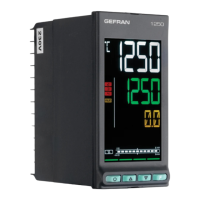144
5.7. Retransmission output
The retransmission output is used mainly to retransmit the
OUT.PW control power.
5.8. Switching the software on/off
5.8.1. How to switch it off
Keep the and keys pressed for 5 seconds to deacti-
vate the controller.
The device goes to an “OFF” state and assumes the beha-
vior of a controller switched off.
The voltage is not switched off: the process variable (PV) di-
splay stays on, but the SV display is off.
All of the outputs (control and alarms) are in an OFF state
(logic level 0, relays de-excited) and all controller functions
are inhibited except for the “POWER-UP” function and serial
communication.
5.9. Soft-Start
If enabled (by setting SOFT.S = ON on the PID configuration
menu), the Soft-Start function slices power based on the
percentage of time lapsed since controller power-on compa-
red to the time set in the parameter SOFT.T
5.10. Tuning
The percentage of actuation value is shown by read-only
parameter OUT. AN on the user configuration menu.
5.8.2. How to switch it on
Keep the key pressed for 5 seconds: the controller
goes from “OFF” to “ON” state.
If voltage is switched off during the “OFF” state, at the next
Power-up the controller returns to “OFF” state (the controller
latches the “ON/OFF”).
Functioning is normally enabled.
To disable it, set the parameter On.OF = disab. on the MODE
configuration menu.
This function can be assigned to a digital input (F.in.x, para-
meter ON-OF), excluding deactivation from the keypad.
Soft-Start is an alternative to Self-Tuning and is activated
after every controller power-on.
The Soft-Start action is reset in Automatic-Manual switching.
5.10.1. Tuning actions
Tuning actions are divided into 3 categories:
• Proportional: action in which the contribution on the
output is proportional to the deviation in input.
• Derivative: action in which the contribution on the
output is proportional to the speed of change of the
deviation in input.
• Integral: action in which the contribution on the output
is proportional to the integral in time of the deviation in
input.
The deviation is the offset between the measured value of
the controlled variable and the setpoint.
Tuning actions let you achieve optimum tuning of the con-
trolled process in every phase.
5.10.1.1. Influence of Proportional, Derivative and Inte-
gral actions on response of controlled process
The response of the controlled process depends on the
type of control action set. Specifically:
• Increasing the Proportional Band reduces oscillations
but increases the deviation.
• Decreasing the Proportional Band reduces the deviation
but causes oscillations of the controlled variable (exces-
sively low Proportional Band values make the system
unstable).
• Increasing the Derivative Action, corresponding to an
increase in Derivative Time, reduces the deviation and
prevents oscillations up to a critical value of Derivative
Time, beyond which it increases the deviation and cau-
ses prolonged oscillations.
• Increasing the Integral Action, corresponding to a de-
crease in Integral Time, tends to cancel the deviation
at full speed between the controlled variable and the
setpoint.
• If the Integral Time value is too long (weak Integral
action), there may be persistence of the deviation
between the controlled variable and the setpoint.
For more information on tuning actions, contact Gefran
Customer Care.
5.10.2. Manual tuning
Manual tuning is done as follows:
1. Set the setpoint to the working value.
2. Set the Proportional Band to 0.1% (with ON-OFF
control).
3. Switch to automatic and watch the behavior of the
variable.
There will be behavior similar to that shown in the
following figure.
5. Examples and applicative notes
The value of the variable is enabled only outside the propor-
tional band. With the alarm active, power is limited to the
value LBA.PW.
The alarm condition ceases if the temperature increases in
heating (in case of decrease in cooling), by setting AL.ACK
= On on the user configuration Menu, or by switching to
Manual mode.

